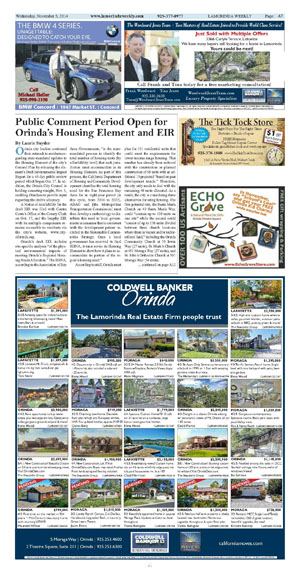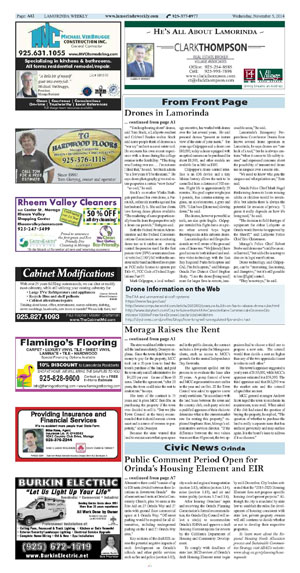|
|
Published November 5th, 2014
|
Public Comment Period Open for Orinda's Housing Element and EIR
|
|
| By Laurie Snyder |
|
|
Orinda city leaders continued their outreach to residents regarding state-mandated updates to the Housing Element of the city's General Plan by releasing the element's Draft Environmental Impact Report for a 45-day public review period which began Oct. 17. In addition, the Orinda City Council is holding a meeting tonight, Nov. 5, enabling Orindans to provide input regarding the draft's adequacy.
 A Notice of Availability for the draft EIR was filed with Contra Costa's Office of the County Clerk on Oct. 17, and the lengthy EIR with its multiple components remains accessible to residents via the city's website, www.cityoforinda.org.
A Notice of Availability for the draft EIR was filed with Contra Costa's Office of the County Clerk on Oct. 17, and the lengthy EIR with its multiple components remains accessible to residents via the city's website, www.cityoforinda.org.
 Orinda's draft EIR includes site-specific analyses "of the physical environmental impacts of meeting Orinda's Regional Housing Needs Allocation." The RHNA, according to the Association of Bay Area Governments, "is the state-mandated process to identify the total number of housing units (by affordability level) that each jurisdiction must accommodate in its Housing Element. As part of this process, the California Department of Housing and Community Development identifies the total housing need for the San Francisco Bay Area for an eight-year period (in this cycle, from 2014 to 2022). ABAG and [the Metropolitan Transportation Commission] must then develop a methodology to distribute this need to local governments in a manner that is consistent with the development pattern included in the Sustainable Communities Strategy. Once a local government has received its final RHNA, it must revise its Housing Element to show how it plans to accommodate its portion of the region's housing need."
Orinda's draft EIR includes site-specific analyses "of the physical environmental impacts of meeting Orinda's Regional Housing Needs Allocation." The RHNA, according to the Association of Bay Area Governments, "is the state-mandated process to identify the total number of housing units (by affordability level) that each jurisdiction must accommodate in its Housing Element. As part of this process, the California Department of Housing and Community Development identifies the total housing need for the San Francisco Bay Area for an eight-year period (in this cycle, from 2014 to 2022). ABAG and [the Metropolitan Transportation Commission] must then develop a methodology to distribute this need to local governments in a manner that is consistent with the development pattern included in the Sustainable Communities Strategy. Once a local government has received its final RHNA, it must revise its Housing Element to show how it plans to accommodate its portion of the region's housing need."
 According to staff, Orinda must plan for 131 residential units that could meet the requirements for lower-income range housing. That number has already been reduced with the construction or planned construction of 68 units with an additional 15 projected "based on past development trends." Therefore, the city only needs to deal with the remaining 48 units allocated. As a result, the city is considering three alternatives for siting housing. The first potential site, the Santa Maria Church on 40 Santa Maria Way, could "contain up to 108 units on one site" while the second could "consist of up to 108 units divided between three church locations where there is vacant and/or underutilized land," including the Orinda Community Church at 10 Irwin Way (27 units), St. Mark's Church at 451 Moraga Way (27 units), and St. John's Orthodox Church at 501 Moraga Way (54 units). Alternative three could "consist of up to 108 units divided between three locations in downtown Orinda" - the aforementioned units at Orinda Community Church, plus 54 units at the Rite Aid on 27 Orinda Way and 27 units with ground floor commercial space at 1 Orinda Way. "Off-street parking would be required for all alternatives, including underground parking on the 1 and 27 Orinda Way sites."
According to staff, Orinda must plan for 131 residential units that could meet the requirements for lower-income range housing. That number has already been reduced with the construction or planned construction of 68 units with an additional 15 projected "based on past development trends." Therefore, the city only needs to deal with the remaining 48 units allocated. As a result, the city is considering three alternatives for siting housing. The first potential site, the Santa Maria Church on 40 Santa Maria Way, could "contain up to 108 units on one site" while the second could "consist of up to 108 units divided between three church locations where there is vacant and/or underutilized land," including the Orinda Community Church at 10 Irwin Way (27 units), St. Mark's Church at 451 Moraga Way (27 units), and St. John's Orthodox Church at 501 Moraga Way (54 units). Alternative three could "consist of up to 108 units divided between three locations in downtown Orinda" - the aforementioned units at Orinda Community Church, plus 54 units at the Rite Aid on 27 Orinda Way and 27 units with ground floor commercial space at 1 Orinda Way. "Off-street parking would be required for all alternatives, including underground parking on the 1 and 27 Orinda Way sites."
 Key sections of the draft EIR assess the potential negative impacts of such development on Orinda's schools and other public services such as fire and police (section 3.12), city roads and regional transportation (section 3.13), utilities (section 3.14), noise (section 3.10), and air and water quality (sections 3.2 and 3.8).
Key sections of the draft EIR assess the potential negative impacts of such development on Orinda's schools and other public services such as fire and police (section 3.12), city roads and regional transportation (section 3.13), utilities (section 3.14), noise (section 3.10), and air and water quality (sections 3.2 and 3.8).
 After hearing Orindans' input and receiving the Orinda Planning Commission's formal recommendation, the Orinda City Council will select a site(s) to accommodate Orinda's RHNA and approve a draft Housing Element update for review by the California Department of Housing and Community Development.
After hearing Orindans' input and receiving the Orinda Planning Commission's formal recommendation, the Orinda City Council will select a site(s) to accommodate Orinda's RHNA and approve a draft Housing Element update for review by the California Department of Housing and Community Development.
 To comply with deadlines of state law, HCD review of Orinda's draft Housing Element must begin by mid-December. City leaders reiterated that the "2015-2023 Housing Element does not propose specific housing development projects." Although the city is mandated by state law to establish the rules for development of housing consistent with state law, private property owners will still continue to decide whether or not to develop their respective properties.
To comply with deadlines of state law, HCD review of Orinda's draft Housing Element must begin by mid-December. City leaders reiterated that the "2015-2023 Housing Element does not propose specific housing development projects." Although the city is mandated by state law to establish the rules for development of housing consistent with state law, private property owners will still continue to decide whether or not to develop their respective properties.
 To learn more about the Regional Housing Needs Allocation process and Sustainable Communities Strategy, visit ABAG's website: www.abag.ca.gov/planning/housingneeds.
To learn more about the Regional Housing Needs Allocation process and Sustainable Communities Strategy, visit ABAG's website: www.abag.ca.gov/planning/housingneeds.

|
|
|
|
|
|
|
|
|
| |
|
|
|
|



